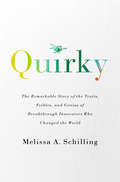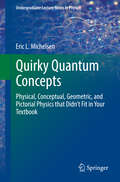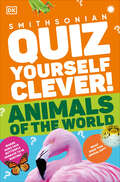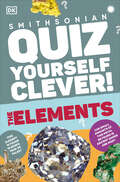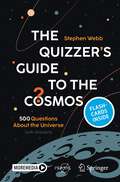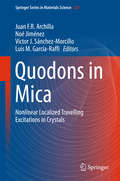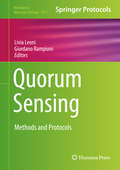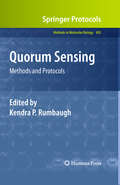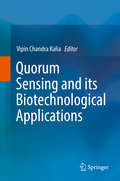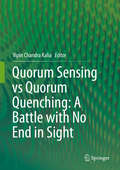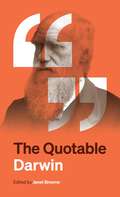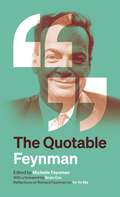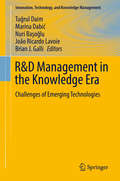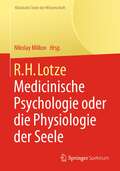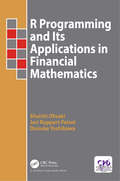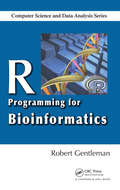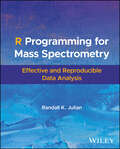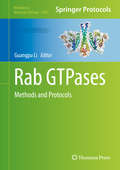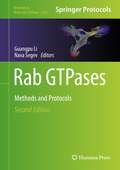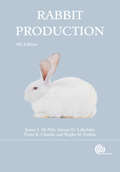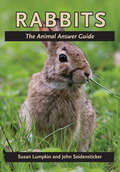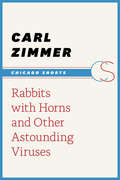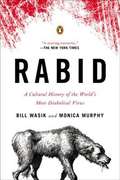- Table View
- List View
Quirky: The Remarkable Story of the Traits, Foibles, and Genius of Breakthrough Innovators Who Changed the World
by Melissa A SchillingThe science behind the traits and quirks that drive creative geniuses to make spectacular breakthroughsWhat really distinguishes the people who literally change the world--those creative geniuses who give us one breakthrough after another? What differentiates Marie Curie or Elon Musk from the merely creative, the many one-hit wonders among us?Melissa Schilling, one of the world's leading experts on innovation, invites us into the lives of eight people--Albert Einstein, Benjamin Franklin, Elon Musk, Dean Kamen, Nikola Tesla, Marie Curie, Thomas Edison, and Steve Jobs--to identify the traits and experiences that drove them to make spectacular breakthroughs, over and over again. While all innovators possess incredible intellect, intellect alone, she shows, does not create a breakthrough innovator. It was their personal, social, and emotional quirkiness that enabled true genius to break through--not just once but again and again.Nearly all of the innovators, for example, exhibited high levels of social detachment that enabled them to break with norms, an almost maniacal faith in their ability to overcome obstacles, and a passionate idealism that pushed them to work with intensity even in the face of criticism or failure. While these individual traits would be unlikely to work in isolation--being unconventional without having high levels of confidence, effort, and goal directedness might, for example, result in rebellious behavior that does not lead to meaningful outcomes--together they can fuel both the ability and drive to pursue what others deem impossible. Schilling shares the science behind the convergence of traits that increases the likelihood of success. And, as Schilling also reveals, there is much to learn about nurturing breakthrough innovation in our own lives--in, for example, the way we run organizations, manage people, and even how we raise our children.
Quirky Quantum Concepts
by Eric L. MichelsenQuirky Quantum Concepts explains the more important and more difficult concepts in theoretical quantum mechanics, especially those which are consistently neglected or confusing in many common expositions. The emphasis is on physical understanding, which is necessary for the development of new, cutting edge science. In particular, this book explains the basis for many standard quantum methods, which are too often presented without sufficient motivation or interpretation. The book is not a simplification or popularization: it is real science for real scientists. Physics includes math, and this book does not shy away from it, but neither does it hide behind it. Without conceptual understanding, math is gibberish. The discussions here provide the experimental and theoretical reasoning behind some of the great discoveries, so the reader may see how discoveries arise from a rational process of thinking, a process which Quirky Quantum Concepts makes accessible to its readers. Quirky Quantum Concepts is therefore a supplement to almost any existing quantum mechanics text. Students and scientists will appreciate the combination of conversational style, which promotes understanding, with thorough scientific accuracy.
Quiz Yourself Clever! Animals of the World (DK Quiz Yourself Clever )
by DKDiscover your own inner Attenborough with this fact-packed, quick-quiztastic book, which covers more than 120 animals, from terrifying tigers to adorable apes!This amazing book welcomes you to the animal kingdom where you can meet more than 100 species, ranging from lions to butterflies and everything in between. Stunning pictures and fast facts will allow you to amass a wealth of knowledge in a fun way. Meet familiar creatures, including polar bears and tigers, and unbelievable ones, such as a vampire bat and a trumpetfish, with each animal having its own quiz questions to test your knowledge on what you've learned. For even more fun, get friends involved and quiz each other!Every creature is shown in beautiful detail, with quiz questions surrounding its portrait. Turn the page to find the answers to the questions—delivered in fast-fact style, including what they eat, where they live, how big they are compared to humans, and more images and facts. A jaw-dropping spectrum of animal types—from fish and birds to reptiles and mammals—provides a learning experience like no other!
Quiz Yourself Clever! Elements (DK Quiz Yourself Clever )
by DKGet to grips with the elements through fun quizzes.The periodic table sets out the humble ingredients of everything in the universe, but with 118 elements, that's a lot of ingredients to remember! This is where Quiz Yourself Clever! Elements comes in.The pure form of every element on the periodic table is shown via an eye-catching image, surrounded by quiz-style questions. Turn the page to find the answers, contained in a handy dataset, from its atomic number and mass to its melting point, and even when it was discovered. Images of how it appears in nature and its uses give a fuller understanding of each element.You can use the book to test your own knowledge, or how about using it to quiz a friend? So, whether you're studying for exams, want to play fun games with friends, or you're just curious about the building blocks of everything around you, you'll be in your element with this book before you know it!
The Quizzer’s Guide to the Cosmos: 500 Questions About the Universe (with Answers) (Springer Praxis Books)
by Stephen WebbHave you ever gazed up at the night sky and wondered how many stars you can see? Whether the universe is infinite? Or, more prosaically, what the chances are of you being hit by a rock from space? The Quizzer’s Guide to the Cosmos is here to satisfy your curiosity by offering an overview of the history of astronomy, from the earliest beginnings through to the most recent discoveries. This isn’t a typical astronomy book, however — it’s packed with a 500-question multiple-choice quiz that not only makes the book more interactive but also helps you retain information and lets you test your knowledge of some of the most captivating concepts in science. The book will appeal to astronomy buffs and to general quiz afficianados alike. Digital questions and answers also via app: Download the Springer Nature Flashcards app free of charge and test your knowledge.
Quodons in Mica
by Juan F. R. Archilla Noé Jiménez Victor J. Sánchez-Morcillo Luis M. García-RaffiThis book presents the current knowledge about nonlinear localized travelling excitations in crystals. Excitations can be vibrational, electronic, magnetic or of many other types, in many different types of crystals, as silicates, semiconductors and metals. The book is dedicated to the British scientist FM Russell, recently turned 80. He found 50 years ago that a mineral mica muscovite was able to record elementary charged particles and much later that also some kind of localized excitations, he called them quodons, was also recorded. The tracks, therefore, provide a striking experimental evidence of quodons existence. The first chapter by him presents the state of knowledge in this topic. It is followed by about 18 chapters from world leaders in the field, reviewing different aspects, materials and methods including experiments, molecular dynamics and theory and also presenting the latest results. The last part includes a personal narration of FM Russell of the deciphering of the marks in mica. It provides a unique way to present the science in an accessible way and also illustrates the process of discovery in a scientist's mind.
Quorum Sensing
by Livia Leoni Giordano RampioniThis detailed volume provides scientists interested in quorum sensing with a broad spectrum of methods and protocols useful for studying bacterial communication processes at the chemico-physical, molecular, and physiological level. Divided into three sections, the content covers detection and quantification of quorum sensing signal molecules, methods for the studying of quorum sensing at the molecular, physiological, and population level, as well as identification and characterization of anti-quorum sensing agents. Written for the highly successful Methods in Molecular Biology series, chapters include introductions to their respective topics, lists of the necessary materials and reagents, step-by-step, readily reproducible laboratory protocols, and tips on troubleshooting and avoiding known pitfalls. Authoritative and cutting-edge, Quorum Sensing: Methods and Protocols serves as a comprehensive guide to the most important methodology currently available in the field.
Quorum Sensing
by Kendra P. RumbaughSince its early days in the 1990s, the Quorum Sensing (QS) field has grown from a few dozen laboratories, investigating the pathways, proteins, and chemicals that facilitate signaling in bacteria, to hundreds of groups that have integrated evolutionary biology, computer science, mathematics, engineering, and metagenomics to create an ever-expanding and dynamic field. In Quorum Sensing: Methods and Protocols, expert researchers provide an in-depth set of diverse protocols that span this broad area of study. Broken into three detailed sections, the volume covers the detection, isolation, and characterization of the QS signals made by both Gram- and Gram+ bacteria, determination of the function of QS signals in vivo, and the development of QS disruption strategies. Written in the highly successful Methods in Molecular BiologyTM series format, chapters include brief introductions to their respective topics, lists of the necessary materials and reagents, step-by-step, readily reproducible laboratory protocols, and expert tips on troubleshooting and avoiding known experimental pitfalls. Comprehensive and cutting-edge, Quorum Sensing: Methods and Protocols serves as an invaluable collection of easily accessible techniques for scientists seeking to further our knowledge about bacterial communication and its relation to humanity.
Quorum Sensing and its Biotechnological Applications
by Vipin Chandra KaliaThis book delves into the biotechnological applications of Quorum sensing (QS)- a peculiar gene-regulatory process of some microorganisms. Quorum Sensing allows a large bacterial population to work together in a coordinated manner to carry out metabolic activities, which individual bacterium cannot. The different chapters describe how, associating bioremediation process with energy generation is an economical proposal, for reducing pollution and managing biowastes. The book discusses how QS can be exploited for biotechnological applications in generating bioproducts, bioenergy, bioremediation, biosensors, health and agricultural activities. It further highlights how QS is becoming an integral part of synthetic biology for genetic circuits for producing: (i) novel products, (ii) biosensors, (iii) bioactive molecules, etc. The book is divided into different sections for a clear understanding of the applicability of QS in, the Environment, Energy, Agriculture and Health sectors.
Quorum Sensing vs Quorum Quenching: A Battle with No End in Sight
by Vipin Chandra KaliaMicrobial relationships with all life forms can be as free living, symbiotic or pathogenic. Human beings harbor 10 times more microbial cells than their own. Bacteria are found on the skin surface, in the gut and other body parts. Bacteria causing diseases are the most worrisome. Most of the infectious diseases are caused by bacterial pathogens with an ability to form biofilm. Bacteria within the biofilm are up to 1000 times more resistant to antibiotics. This has taken a more serious turn with the evolution of multiple drug resistant bacteria. Health Departments are making efforts to reduce high mortality and morbidity in man caused by them. Bacterial Quorum sensing (QS), a cell density dependent phenomenon is responsible for a wide range of expressions such as pathogenesis, biofilm formation, competence, sporulation, nitrogen fixation, etc. Majority of these organisms that are important for medical, agriculture, aquaculture, water treatment and remediation, archaeological departments are: Aeromonas, Acinetobacter, Bacillus, Clostridia, Enterococcus, Pseudomonas, Vibrio and Yersinia spp. Biosensors and models have been developed to detect QS systems. Strategies for inhibiting QS system through natural and synthetic compounds have been presented here. The biotechnological applications of QS inhibitors (QSIs) in diverse areas have also been dealt with. Although QSIs do not affect growth and are less likely to impose selective pressure on bacteria, however, a few reports have raised doubts on the fate of QSIs. This book addresses a few questions. Will bacteria develop mechanisms to evade QSIs? Are we watching yet another defeat at the hands of bacteria? Or will we be acting intelligently and survive the onslaughts of this Never Ending battle?
The Quotable Darwin
by Janet BrowneA treasure trove of illuminating and entertaining quotations from the legendary naturalistHere is Charles Darwin in his own words—the naturalist, traveler, scientific thinker, and controversial author of On the Origin of Species, the book that shook the Victorian world. Featuring hundreds of quotations carefully selected by world-renowned Darwin biographer Janet Browne, The Quotable Darwin draws from Darwin’s writings, letters to friends and family, autobiographical reminiscences, and private scientific notebooks. It offers a multifaceted portrait that takes readers through his youth, the famous voyage of the Beagle, the development of his thoughts about evolution, his gradual loss of religious faith, and the time spent turning his ideas into a well-articulated theory about the natural origin of all living beings—a theory that dangerously included the origin of humans.The Quotable Darwin also includes many of the key responses to Darwin’s ideas from figures across the social spectrum, scientists and nonscientists alike—and criticism too. We see Darwin as an innovative botanist and geologist, an affectionate husband and father, and a lively correspondent who once told his cousin that he liked to play billiards because “it drives the horrid species out of my head.” This book gives us an intimate look at Darwin at work, at home, as a public figure, and on his travels.Complete with a chronology of Darwin’s life by Browne, The Quotable Darwin provides an engagingly fresh perspective on a remarkable man who was always thinking deeply about the natural world.
The Quotable Feynman
by Richard P. FeynmanA treasure-trove of illuminating and entertaining quotations from beloved physicist Richard P. Feynman"Some people say, ‘How can you live without knowing?' I do not know what they mean. I always live without knowing. That is easy. How you get to know is what I want to know."—Richard P. FeynmanNobel Prize–winning physicist Richard P. Feynman (1918–88) was that rarest of creatures—a towering scientific genius who could make himself understood by anyone and who became as famous for the wit and wisdom of his popular lectures and writings as for his fundamental contributions to science. The Quotable Feynman is a treasure-trove of this revered and beloved scientist's most profound, provocative, humorous, and memorable quotations on a wide range of subjects.Carefully selected by Richard Feynman's daughter, Michelle Feynman, from his spoken and written legacy, including interviews, lectures, letters, articles, and books, the quotations are arranged under two dozen topics—from art, childhood, discovery, family, imagination, and humor to mathematics, politics, science, religion, and uncertainty. These brief passages—about 500 in all—vividly demonstrate Feynman's astonishing yet playful intelligence, and his almost constitutional inability to be anything other than unconventional, engaging, and inspiring. The result is a unique, illuminating, and enjoyable portrait of Feynman's life and thought that will be cherished by his fans at the same time that it provides an ideal introduction to Feynman for readers new to this intriguing and important thinker.The book features a foreword in which physicist Brian Cox pays tribute to Feynman and describes how his words reveal his particular genius, a piece in which cellist Yo-Yo Ma shares his memories of Feynman and reflects on his enduring appeal, and a personal preface by Michelle Feynman. It also includes some previously unpublished quotations, a chronology of Richard Feynman's life, some twenty photos of Feynman, and a section of memorable quotations about Feynman from other notable figures.Features:Approximately 500 quotations, some of them previously unpublished, arranged by topicA foreword by Brian Cox, reflections by Yo-Yo Ma, and a preface by Michelle FeynmanA chronology of Feynman's lifeSome twenty photos of FeynmanA section of quotations about Feynman from other notable figuresSome notable quotations of Richard P. Feynman:"The thing that doesn't fit is the most interesting.""Thinking is nothing but talking to yourself inside.""It is wonderful if you can find something you love to do in your youth which is big enough to sustain your interest through all your adult life. Because, whatever it is, if you do it well enough (and you will, if you truly love it), people will pay you to do what you want to do anyway.""I'd hate to die twice. It's so boring."
R&D Management in the Knowledge Era: Challenges of Emerging Technologies (Innovation, Technology, and Knowledge Management)
by Tuğrul Daim Marina Dabić Nuri Başoğlu João Ricardo Lavoie Brian J. GalliThis volume explores emerging models, methods and tools in the management of research and development (R&D) in the knowledge era, with a particular focus on the challenges of the emerging technologies. The contributions are organized in five parts. Part I, Managing Emerging Technologies, provides methods and tools to understand the challenges created by the emergence of new technologies. Part II, Technology and Engineering Management Tools and Policies, explores different technology and engineering tools, including topics such as product concept development, design, selection and adoption, using technology roadmaps and bibliometrics. Part III, Technological Innovation and Entrepreneurship, explores R&D, knowledge transfer and entrepreneurial education. Part IV, Commercialization of Technological Innovations, explores the development and application of the technology transfer process which allows managers to succeed in commercializing the outcomes of R&D projects. Part V, Managing the Engineering Enterprise, explores the effect economic decision-making, leadership styles, change management and quality management have on an organization’s ability to plan and execute initiatives and projects. Research and Development has always played a critical role in the engineering and technology focused industries. In an era of big data and smart applications, knowledge has become a key enabler for R&D. Managing R&D in the knowledge era requires use of key tools and methods. However, emerging technologies pose many challenges and cause uncertainties or discontinuities, which make the task of managing R&D even more difficult. This book will examine these challenges and provide tools and methods to overcome them. Exploring such industries as automotive, healthcare, business intelligence, energy and home appliances, this book is a valuable resource for academics, scholars, professionals and leaders in innovation, R&D, technology, and engineering management.
R.H. Lotze: Medicinische Psychologie oder die Physiologie der Seele (Klassische Texte der Wissenschaft)
by Nikolay MilkovOriginaltext mit philosophischen sowie historischen Kommentaren von Nikolay Milkov Als habilitierter Mediziner und Philosoph hat Rudolph Hermann Lotze durch seinen interdisziplinären Ansatz die Entwicklung der Psychologie im 19. Jahrhundert wie kein anderer geprägt. Im Unterschied zu anderen Wissenschaftlern der Zeit hat Lotze die neue Disziplin konsequent in enger Verbindung mit der Philosophie betrachtet, wie besonders in Medicinische Psychologie oder Physiologie der Seele (1852) deutlich wird. Dies bedeutete seine bewusste Abkehr von der Herangehensweise, die Psychologie ganz über experimentelle Untersuchungen und damit die Empirie zu definieren. Lotze scheute sich jedoch, diese entstehende Disziplin „philosophische Psychologie“ zu nennen, für ihn war sie nur physiologische Psychologie, herausgearbeitet mit Hilfe der Philosophie: Sie stellt Tatsachen fest und untersucht, wie Körper und Seele sich zueinander verhalten, tut dies jedoch nicht nur empirisch, sondern auch „metaphysisch“. In diesem Band wird Lotzes Originaltext untersucht, kommentiert und eingebettet in den soziokulturellen Hintergrund der Entstehungszeit, um einen tiefen, aber verständlichen Einblick in diesen Bereich der Psychologie zu geben.
R Programming and Its Applications in Financial Mathematics
by Shuichi Ohsaki Jori Ruppert-Felsot Daisuke YoshikawaThis book provides an introduction to R programming and a summary of financial mathematics. <P><P>It is not always easy for graduate students to grasp an overview of the theory of finance in an abstract form. For newcomers to the finance industry, it is not always obvious how to apply the abstract theory to the real financial data they encounter. Introducing finance theory alongside numerical applications makes it easier to grasp the subject. <P><P>Popular programming languages like C++, which are used in many financial applications are meant for general-purpose requirements. They are good for implementing large-scale distributed systems for simultaneously valuing many financial contracts, but they are not as suitable for small-scale ad-hoc analysis or exploration of financial data. The R programming language overcomes this problem. R can be used for numerical applications including statistical analysis, time series analysis, numerical methods for pricing financial contracts, etc. <P><P>This book provides an overview of financial mathematics with numerous examples numerically illustrated using the R programming language.
R Programming for Bioinformatics (Chapman & Hall/CRC Computer Science & Data Analysis)
by Robert GentlemanDue to its data handling and modeling capabilities as well as its flexibility, R is becoming the most widely used software in bioinformatics. R Programming for Bioinformatics explores the programming skills needed to use this software tool for the solution of bioinformatics and computational biology problems.Drawing on the author's first-hand exper
R Programming for Mass Spectrometry: Effective and Reproducible Data Analysis
by Randall K. JulianA practical guide to reproducible and high impact mass spectrometry data analysis R Programming for Mass Spectrometry teaches a rigorous and detailed approach to analyzing mass spectrometry data using the R programming language. It emphasizes reproducible research practices and transparent data workflows and is designed for analytical chemists, biostatisticians, and data scientists working with mass spectrometry. Readers will find specific algorithms and reproducible examples that address common challenges in mass spectrometry alongside example code and outputs. Each chapter provides practical guidance on statistical summaries, spectral search, chromatographic data processing, and machine learning for mass spectrometry. Key topics include: Comprehensive data analysis using the Tidyverse in combination with Bioconductor, a widely used software project for the analysis of biological dataProcessing chromatographic peaks, peak detection, and quality control in mass spectrometry dataApplying machine learning techniques, using Tidymodels for supervised and unsupervised learning, as well as for feature engineering and selection, providing modern approaches to data-driven insightsMethods for producing reproducible, publication-ready reports and web pages using RMarkdown R Programming for Mass Spectrometry is an indispensable guide for researchers, instructors, and students. It provides modern tools and methodologies for comprehensive data analysis. With a companion website that includes code and example datasets, it serves as both a practical guide and a valuable resource for promoting reproducible research in mass spectrometry.
Rab GTPases
by Guangpu LiThis volume covers the latest technological advances in the characterization of the biosynthesis and functions of Rab GTPases and their regulation by guanine nucleotide exchange factors (GEFs) and GTPase-activating proteins (GAPs). The book consists of 28 chapters and starts with an overview of the Rab GTPase family. The next few chapters describe systematic approaches to the identification and classification of Rabs and Rab GAPs, as well as the detection of Rab isoprenylation and membrane distribution. The last few chapters examine the biochemical and functional properties of individual Rabs in the order of exocytic, recycling and endocytic Rabs. Written in the highly successful Methods of Molecular Biology series format, chapters include introductions to their respective topics, lists of the necessary materials and reagents, step-by-step, readily reproducible laboratory protocols and key tips on troubleshooting and avoiding known pitfalls. Instructive and practical, Rab GTPases: Methods and Protocols approaches each topic with great detail and is a valuable resource for researchers and students interested in the field of Rab GTPases.
Rab GTPases: Methods and Protocols (Methods in Molecular Biology #2293)
by Guangpu Li Nava SegevThis second edition volume expands on the previous edition with a discussion of new research and discoveries in the Rab field. Chapters in this book cover topics such as new information on Rab regulation and localization; interaction; function; and diseases. Written in the highly successful Methods in Molecular Biology series format, chapters include introductions to their respective topics, lists of the necessary materials and reagents, step-by-step, readily reproducible laboratory protocols, and tips on troubleshooting and avoiding known pitfalls. Cutting-edge and comprehensive, Rab GTPases: Methods and Protocols, Second Edition is a valuable resource for scientists working in the fields of Rab and other small GTPases, and beyond.
Rabbit Production
by James McNitt Nephi Patton Steven Lukefahr Peter Robert CheekeThis new edition of Rabbit Production is fully updated throughout. Mainly concerning rabbits bred for meat and fur, it also contains practical information on pet rabbits, show rabbits and rabbits used as laboratory animals. Core topics are covered, including rabbit genetics, reproduction, health and diseases, behaviour, welfare, fur and meat production, rabbit production in developing countries, slaughter and the marketing of rabbit products. Current areas of interest such as animal welfare and coat colour genetics are expanded in the new edition. An important resource for all those involved in rabbit production, this book is also vital reading for students and researchers of animal science and meat production, as well as the keen amateur rabbit enthusiast.
Rabbit Production
by Nephi Patton Peter Robert Cheeke Steven Lukefahr James McnittThis new edition of Rabbit Production is fully updated throughout. Mainly concerning rabbits bred for meat and fur, it also contains practical information on pet rabbits, show rabbits and rabbits used as laboratory animals. Core topics are covered, including rabbit genetics, reproduction, health and diseases, behaviour, welfare, fur and meat production, rabbit production in developing countries, slaughter and the marketing of rabbit products. Current areas of interest such as animal welfare and coat colour genetics are expanded in the new edition. An important resource for all those involved in rabbit production, this book is also vital reading for students and researchers of animal science and meat production, as well as the keen amateur rabbit enthusiast.
Rabbits: The Animal Answer Guide (The Animal Answer Guides: Q&A for the Curious Naturalist)
by Susan Lumpkin John SeidenstickerDid you know that there are more than 90 species of rabbits, hares, and pikas, rabbits' little-known cousins? And that new species are still being found? Or that baby rabbits nurse from their mothers only once a day? How about that some people brew medicinal tea from rabbit pellets? Wildlife conservationists Susan Lumpkin and John Seidensticker have all the answers—from the mundane to the unbelievable—about the world’s leaping lagomorphs. To some, rabbits are simply a docile pet for the classroom or home. To others, they are the cute animals munching on clover or the pests plaguing vegetable gardens. Whatever your interest, in Rabbits: The Animal Answer Guide you will discover that they are a more complex group than you might have first imagined. Lumpkin and Seidensticker take these floppy-eared creatures out of the cabbage patch and into the wild, answering 95 frequently asked questions about these familiar and fascinating animals.With informative photographs and an accessible format, Rabbits: The Animal Answer Guide is the one resource you will need to learn about rabbits' anatomy and physiology, evolutionary history, ecology, behavior, and their relationships with humans. Lumpkin and Seidensticker also talk about conservation, because while rabbits may breed like, well, rabbits, several species are among the most endangered animals on Earth.
Rabbits with Horns and Other Astounding Viruses
by Carl ZimmerViruses are the smallest living things known to science, yet they hold the entire planet in their sway. Rabbits with Horns and Other Astounding Viruses explores the bizarre places viruses dwell, and considers the often unexpected ways they influence our world. From agricultural production and crystal caves to rabbits with horns and cervical cancer, viruses are behind many of the wonders--some fascinating, some frightening--of the natural world, as well as some of our greatest medical challenges. Through his engaging considerations of the tobacco mosaic virus, viruses in ocean algae, and the human papillomavirus, award-winning science writer Carl Zimmer brings us up to speed on the nuances and depth of today's cutting-edge scientific research on virology.
Rabid: A Cultural History of the World's Most Diabolical Virus
by Bill Wasik Monica MurphyA maddened creature, frothing at the mouth, lunges at an innocent victim--and, with a bite, transforms its prey into another raving monster. It's a scenario that underlies our darkest tales of supernatural horror, but its power derives from a very real virus, a deadly scourge known to mankind from our earliest days. In this fascinating exploration, journalist Bill Wasik and veterinarian Monica Murphy chart four thousand years in the history, science, and cultural mythology of rabies.The most fatal virus known to science, rabies kills nearly 100 percent of its victims once the infection takes root in the brain. A disease that spreads avidly from animals to humans, rabies has served throughout history as a symbol of savage madness, of inhuman possession. And today, its history can help shed light on the wave of emerging diseases, from AIDS to SARS to avian flu, that we now know to originate in animal populations. From Greek myths to zombie flicks, from the laboratory heroics of Louis Pasteur to the contemporary search for a lifesaving treatment, Rabid is a fresh, fascinating, and often wildly entertaining look at one of mankind's oldest and most fearsome foes.
Rabid: A Cultural History of the World's Most Diabolical Virus
by Bill Wasik Monica MurphyA maddened creature, frothing at the mouth, lunges at an innocent victim—and, with a bite, transforms its prey into another raving monster. It’s a scenario that underlies our darkest tales of supernatural horror, but its power derives from a very real virus, a deadly scourge known to mankind from our earliest days. In this fascinating exploration, journalist Bill Wasik and veterinarian Monica Murphy chart four thousand years in the history, science, and cultural mythology of rabies. The most fatal virus known to science, rabies kills nearly 100 percent of its victims once the infection takes root in the brain. A disease that spreads avidly from animals to humans, rabies has served throughout history as a symbol of savage madness, of inhuman possession. And today, its history can help shed light on the wave of emerging diseases, from AIDS to SARS to avian flu, that we now know to originate in animal populations. From Greek myths to zombie flicks, from the laboratory heroics of Louis Pasteur to the contemporary search for a lifesaving treatment, Rabid is a fresh, fascinating, and often wildly entertaining look at one of mankind’s oldest and most fearsome foes. .
